As two of the most iconic safari destinations on Earth, both Kenya and Tanzania are home to an abundance of wildlife.
Together, the neighbouring East African countries form the Serengeti-Mara ecosystem – one of the world’s largest protected areas, spanning approximately 30,000 square kilometres.
I've done a combined Kenya-Tanzania safari before and it was an incredible experience.
I found it really easy to start my tour in Northern Tanzania viewing the wildebeest migration in the Serengeti; then journeying alongside the mighty Mara River into Kenya to watch the completion of this amazing annual ritual.
And this was just one of many amazing things I got to do during my trip.
In this article, I'll share my best insights on Kenya and Tanzania as the ultimate destinations for your next and best safari experience.
Let's get started.
My Quick Takeaways:
Deciding between a safari in Kenya or Tanzania? Here's what you need to know at a glance:
Shared Wonders:
- Great Migration: Both countries offer the chance to witness the annual wildebeest migration within the Serengeti-Mara ecosystem.
- Diverse Wildlife: Each boasts rich biodiversity, including the Big Five: lion, elephant, buffalo, leopard, and rhinoceros.
Key Differences:
Size and Accessibility:
- Tanzania: Larger in land area with more expansive national parks, offering a sense of vast wilderness.
- Kenya: Smaller and more developed, with better infrastructure facilitating easier access to safari destinations.
Tourism and Crowds:
- Tanzania: Generally less crowded, providing a more secluded safari experience.
- Kenya: More tourists due to its established safari industry, which can lead to busier parks.
Cost Considerations:
- Kenya: Often more budget-friendly, with a wider range of accommodation options and lower internal travel costs.
- Tanzania: Tends to be pricier, especially for premium experiences in exclusive reserves.
Unique Highlights:
Tanzania:
- Ngorongoro Crater: A natural enclosure teeming with diverse wildlife.
- Zanzibar: Pristine beaches and rich cultural history, ideal for post-safari relaxation.
Kenya:
- Maasai Mara: Renowned for its high concentration of big cats and the dramatic river crossings during the migration.
- Cultural Interactions: Opportunities to engage with Maasai communities and experience their traditions.
Still can't decide between a Kenya or Tanzania safari? Let's take a deeper dive and I'll help you decide.
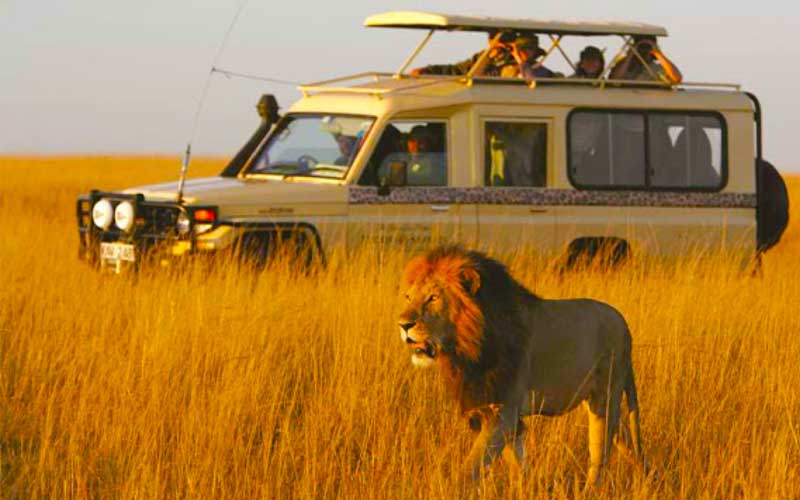
Plan your Safari experience
Check out these amazing deals on epic safari experiences now.
Safari Kenya or Tanzania FAQs
What makes Kenya and Tanzania so similar yet different?
While Kenya and Tanzania share similarities in climates, wildlife species, vegetation, and opportunities to witness the Great Migration, they are also each characterised by differences in unique wildlife spectacles and world-renowned landscapes.
Ensuring that a visit to either country is equally as satisfying and yet different to the other.
Here are some of their other key similarities and differences:
Similarities | Differences |
|---|---|
Both countries share a common border and a coastline on the Indian Ocean with breathtaking holiday destinations like Chale Island and Zanzibar. | Tanzania has 19 national parks and 7 game reserves while Kenya has 9 national parks and 7 national game reserves. |
Both countries are popular tourist destinations for safaris. | Tanzania is a bigger country while Kenya is smaller and more crowded with tourists. |
Both countries boast diverse wildlife populations and ecosystems. | Kenya is a cheaper safari destination with a wider variety of accommodation and reduced flight prices available for tourists. |
You can view the Great Wildebeest Migration in both countries. |
Which country is better for your budget - Kenya or Tanzania?
Overall, Kenya is better for your budget as a potential safari destination.
It's a smaller country than Tanzania, so it's quicker and cheaper to travel by plane, car or ferry to its national parks.
With its great investment in the tourism industry and wide range of options when it comes to accommodation and flights, Kenya is generally more budget-friendly.
Kenya is also a wealthier country in comparison to Tanzania, so it is better equipped with airports, transport, hotels and guest houses.
However, Kenya also has less wildlife and national parks than Tanzania, so it would be a good idea to also spend time in Tanzania if you can afford it.
I created a handy guide for enjoying Tanzania on a budget.
Both Kenya and Tanzania offer great off-season deals and various accommodation options to suit your budget best.
While the sky is the limit for both countries when it comes to organizing luxury safari packages, these can be easily avoided.
If budget isn’t the issue but rather safety, you’ll be happy to discover that both countries have a low crime rate against tourists.
Precautions should always be taken, however, especially in the major cities like Nairobi, Mombasa and Dar es Salaam.
Which tour? Here are 5 Kenya-Tanzania safaris I highly recommend:
- Serengeti Trail Safari (incl. Nairobi, Kisii and Kisumu) (8 days)
- Masai Camping Safari (incl. Serengeti and Lake Manyara) (10 days)
- Best of Kenya and Tanzania (incl. Amboseli and Tarangire) (12 days)
- Kenya and Tanzania Camping Safari (incl. Maasai Mara and Lake Nakuru) (14 days)
- Best of East Africa (incl. Subukloita Hills and Zanzibar) (20 days)
See more Kenya and Tanzania safari deals.
When is the best time of year to visit Kenya or Tanzania?
Kenya and Tanzania share similar climates, so the best time of year to visit either country is during the dry season (June-October) for more wildlife sightings and easier travelling conditions.
Both Kenya and Tanzania are notably marked by two distinct seasons: the wet season and the dry season.

Plan your Safari experience
Check out these amazing deals on epic safari experiences now.
Dry Season – Best Time for Safaris
The best and most popular times to visit Tanzania and Kenya are generally from mid-June to October. As East Africa’s dry season, this time of year has the most predictable weather and provides ideal safari conditions.
While early mornings and evenings might be cold, the temperature during this season is fairly predictable. Thermometer readings are often around 23°C/73°F, reaching a high of 28°C/82°F in the coastal areas.
Wet Season – Best Off-Season Deals
During the wet season, the dry Tanzanian and Kenyan landscapes are transformed into a lush, green paradise. Temperatures increase during this period and usually range between 24°C/75°F and 27°C/81°F, reaching highs of 30°C/86°F along the coast.
There are two types of rainy periods in this season:
Short rains - November to December
Long rains - March to April
Short rains (November-December):
Afternoon thunderstorms are often expected to take place, but safaris are unlikely to be impacted. For this reason, the short rainy season is still considered an excellent time to plan a trip to Tanzania or Kenya.
Long rains (March-April):
The long rains usher in the peak of the wet season. While it may still be a good time to visit Tanzania or Kenya, your trip will be impacted by the amount of rain and the type of conditions the area receives that year.
Tourists who find hot, humid conditions unpleasant should preferably avoid this season.
If you’re up for an adventure, there are major advantages of travelling here during this time.
Prices are reduced dramatically and with crowds being dispersed – you’ll have thrilling wildlife sightings all to yourself.
Read our article on average safari costs in Tanzania.
Where to stay? Here are 5 of my favourite accommodation options in Kenya and Tanzania:
- Talek Bush Camp (Masai Mara)
- Lake Nakuru Lodge
- Eco Camp (Amboseli)
- Mawe Camp (Serengeti)
- Serena Safari Lodge (Ngorongoro)
See more popular Kenya and Tanzania safari accommodation options.
What are the most iconic National Parks in Tanzania and their main attractions?
The most iconic national parks in Tanzania are arguably Serengeti, Ngorongoro, Gombe and Mahale for their diverse wildlife and stunning locations.
With that said, there are so many exceptional national parks to explore in Tanzania that makes for a unique safari experience.
Serengeti National Park
As Tanzania’s conservation centrepiece, the Serengeti is home to one of the world’s densest wildlife populations.
Serengeti is a local Masaai word that is used to describe endless plains – a perfect depiction of the park’s rolling golden grasslands.
While the main attraction of the Serengeti is the Wildebeest Migration, the park is an all-year-round safari destination with ample opportunity to spot the Big Five.
Ngorongoro Crater
Nestled below a heavily forested 600m volcanic rim is a wildlife wonderland called Ngorongoro - offering some of Tanzania’s best and most reliable safari sightings.
Before the iconic volcano erupted, it once stood taller than the mighty Mount Kilimanjaro itself.
The top of the ancient volcanic cone collapsed after the loss of its underlying body of magma and ultimately formed what is now recognised as the largest inactive caldera on earth.
Lake Manyara
In the rush to see the Serengeti and its famous Ngorongoro neighbour, Lake Manyara can easily be overlooked.
Conveniently located on the road from the town of Arusha to Ngorongoro, Lake Manyara offers a magical stop for traveller’s looking to explore the more popular parks on the Northern Safari Circuit.
The park takes up a mere 330 square kilometres of which 230 square kilometres are covered by the shallow alkaline lake.
The rest of the landscape boasts a remarkable mix of floodplains, acacia woodlands, and forests that supports an equally impressive variety of wildlife.
Most notable is the park’s large elephant population, resident baboons and black-maned tree-climbing lions. The lake is also home to thousands of pink flamingos and over 400 bird species.
Tarangire National Park
As one of the untouched gems of Tanzania, Tarangire National Park sees fewer visitors than other parks on the Northern Safari Circuit.
In stark contrast to the small crowds of tourists is the park’s teeming wildlife population that at the right time of year is believed to deliver some of the best game-viewing in Tanzania.
Not only does it tick off the classic safari sightings that every visitor hopes to see, but offers some unusual species to spot as well – like the long-necked gerenuk. With 550 species to encounter, Tarangire is a veritable bird-watching paradise.

Plan your Safari experience
Check out these amazing deals on epic safari experiences now.
Off-the-Grid National Parks
The lesser-visited national parks of Tanzania are hidden gems that offer some of the country’s most sought-after safari sightings.
The mostly inaccessible tracks that lead to Katavi, Mahale Mountains, Selous and Ruaha National Park have deterred crowds of tourists and concealed some of Africa’s best-kept safari secrets.
As Tanzania’s third largest park, Katavi National Park is comprised of approximately 4,471 square kilometres of everything from open grasslands and forests to floodplains and seasonal lakes.
As these floodplains retreat during the dry season, the sight of hippos by their hundreds cramming into dwindling pools is one of the main attractions of the park.
What makes Mahale Mountains National Park especially unique is that it does not boast the usual Tanzanian safari suspects such as lions and elephants.
Instead, it is famously known for offering an enthralling opportunity to trek and get up close with its world-renowned population of chimpanzees.
Selous National Park holds the title as Africa’s largest game reserve and is nearly four times the size of the Serengeti.
The park’s stand-out features include its resident Big Five population and the mighty Rufiji River that fills the landscape with interconnected lakes.
Unlike Tanzania’s other national parks, Selous offers the unique opportunity to experience guided walks and fly-camping.
Home to sweeping herds of antelope, all-conquering prides of large carnivores, elephant families that churn up the river beds, as well as a vibrant bird population – the Ruaha National Park is one of our planet’s last remaining vestiges for nature in its rawest form.
The park’s unparalleled predator sightings and resident lion population has put Ruaha in the spotlight in recent years.
Which tour? Here are 5 Kenya-Tanzania safaris I highly recommend:
- Serengeti Trail Safari (incl. Nairobi, Kisii and Kisumu) (8 days)
- Masai Camping Safari (incl. Serengeti and Lake Manyara) (10 days)
- Best of Kenya and Tanzania (incl. Amboseli and Tarangire) (12 days)
- Kenya and Tanzania Camping Safari (incl. Maasai Mara and Lake Nakuru) (14 days)
- Best of East Africa (incl. Subukloita Hills and Zanzibar) (20 days)
See more Kenya and Tanzania safari deals.
What are the most iconic National Parks in Kenya and their main attractions?
The most iconic national park in Kenya is arguably Masai Mara for its unique perspective on the Wildebeest Migration and rich cultural heritage.
Masai Mara National Reserve
Holding a similar status as the Serengeti in Tanzania is Kenya’s flagship conservation area – the Masai Mara National Reserve.
While the park is most famously known for the role it plays in the Great Migration, it is also home to safari heavyweights like the Big Five and is especially popular for its big cat sightings.
But this doesn't mean there aren't other notable national parks with diverse ecosystems in Kenya. Here are a few more of them below:
Amboseli National Park
With only the Masai Mara outshining the park in terms of popularity, the Amboseli National Park is one of Kenya’s main drawcards.
Amboseli boasts an impressive population of elephants and is the only safari destination in Kenya that offers unparalleled views of the snow-capped Mount Kilimanjaro.

Plan your Safari experience
Check out these amazing deals on epic safari experiences now.
Nairobi National Park
As Kenya’s capital and the starting point of most safaris, a stop in Nairobi is almost inevitable.
Contrasting the bustling city centre is the opportunity for a peaceful safari retreat set against the backdrop of skyscrapers.
In Nairobi itself is the famous Daphne Sheldrick Elephant Orphanage and the world-renowned Giraffe Manor. Just outside of the town is the Nairobi National Park – home to everything from lions and giraffes to an impressive 550 species of birds.
Samburu National Reserve
Nestled on the edge of the Ewaso Ng'iro River is the Samburu National Reserve. With its diverse mix of grassland and forests, the reserve attracts all the big cats, huge herds of elephants and even a rare species of wild dog.
A major highlight is the ‘Samburu Big 5’ – a unique list of animals that aren’t found in the more popular reserves of Kenya.
Adding a thrill to every Samburu safari is the chance to spot the Grevy’s zebra, the long-necked gerenu, reticulated giraffe, besia oryx and Somali ostrich.
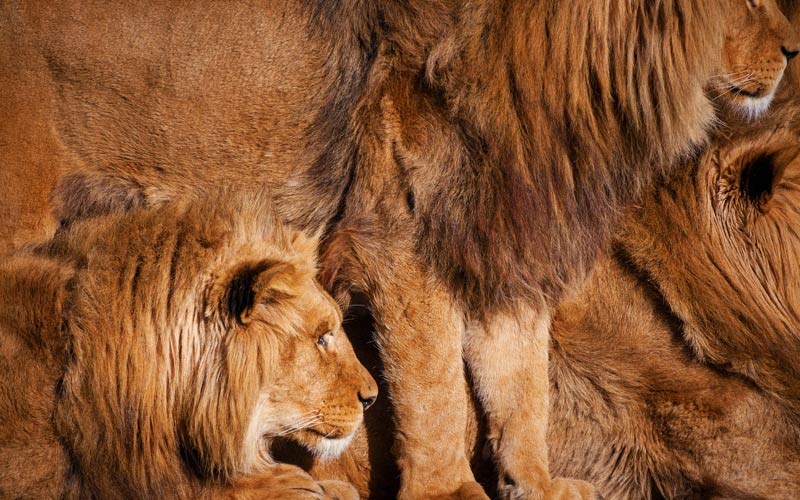
A Private Kenyan Safari Experience
One of the most authentic ways to experience the African wilderness is by visiting private game reserves and conservancies. Far-removed from the fleet of safari vehicles is an opportunity to encounter wildlife in its truest and most untainted form.
Kenya boasts an array of popular conservancies. The Mara Conservancies are pieces of land that have been set aside next to the Masai Mara National Reserve – far removed from the crowds that flock to this area during the wildebeest river crossings.
Other popular private reserves in Kenya include Selenkay Conservancy, Ol Kinyei Conservancy, Ol Pejeta Conservancy, Naboisho Conservancy, Olare Motorogi Conservancy and the rugged Laikipia.
If you’re looking for a unique safari experience, most private conservancies usually offer the added adventure of signing up for a walking or nighttime safari.
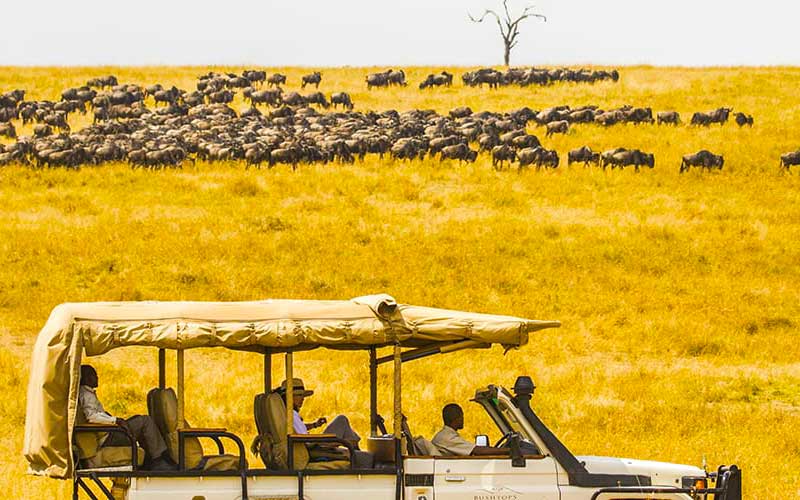
Which country is better for witnessing The Great Migration – Kenya or Tanzania?
Overall, Tanzania is better for witnessing The Great Wildebeest Migration because you can follow the wildebeest in more locations and for longer periods.
In contrast, Kenya is the final destination when the wildebeest cross through the Mara River.
The rolling grasslands of Kenya and Tanzania are most famously known for the Great Migration. Arguably, timing your trip to coincide with witnessing this unimaginably spectacular event is of paramount importance.
Understanding the pattern of the migration will help you decide where you’d like to witness it most.
In general, the migration tends to be in Tanzania in the Southern Serengeti for the calving season from February to mid-March.
From June-July, the herds can be spotted in the park’s Western Corridor as they gather near the Grumeti River.
From August-September, the grazers move into the Northern Serengeti and Kenya’s Masai Mara National Reserve.
During this season you have the chance of witnessing the famous river crossings across the crocodile-infested Mara River.
The sweeping herds then head back down to the Southern Serengeti, and the cycle starts again.
To give you a better sense of locations and timing as the wildebeest make their way through Tanzania and Kenya, here is a handy map:
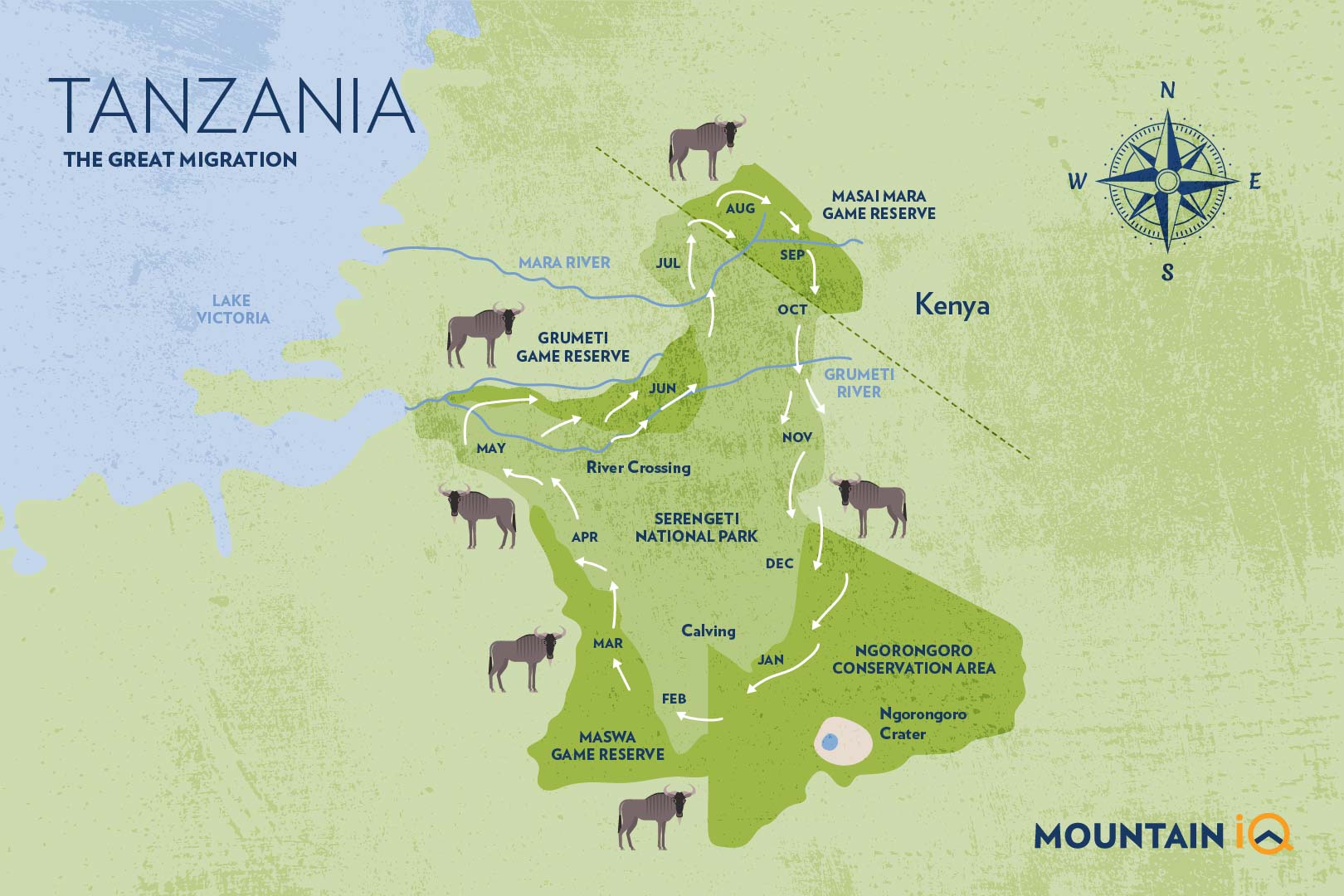
Calving season in the Serengeti – Late January-February
As the migration slows down, the calving season in the Serengeti offers the safari experience of a lifetime.
Not only does this time of year give you the chance to witness the wildebeest drop their young, but also brings with it an unprecedented opportunity for predator sightings.
With up to 8,000 calves being born each day, many travellers rate the calving season as the greatest spectacle of the Serengeti.
The calves are quick to their feet, standing within a few minutes of being born and learn to run within a few days.
With lurking big cats looking to strike when the herds are most vulnerable, the calving season ushers in a high concentration of predators to the Southern Serengeti and Western Ngorongoro Conservation Area.
As the grasses of the Southern Serengeti become depleted, the herds then make their way back to the Masai Mara.
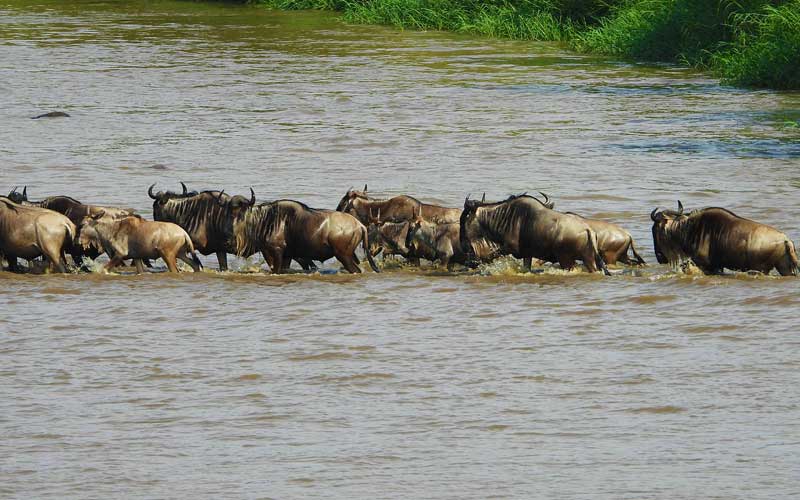
Famous Mara River Crossings – August and September
From August-September, the grazers move into the Northern Serengeti and Kenya’s Masai Mara National Reserve. Here they face the daunting challenge of crossing the notorious Mara River.
The best time to witness this iconic event is generally in August.
It is important to note, however, that the exact time the herds cross the river is very unpredictable – not even the wildebeest themselves know!
The nervous herds often spend anything from hours to days along the bank before they pluck up the courage to face the crocodile-infested waters, strong currents and looming predators on the other side of the river.
The river also has many crossing points into Kenya, so having the knowledge of an experienced safari guide is highly recommended.
After the herd cross the Mara River, Kenya is the best place to continue to see them until they head back to the Serengeti once more.

Plan your Safari experience
Check out these amazing deals on epic safari experiences now.
My Final Thoughts
I hope this article helps you choose between where to travel for your dream East African adventure. But why choose when you can have your cake and eat it? With the right budget, a combined Kenya and Tanzania safari is just one click away.
